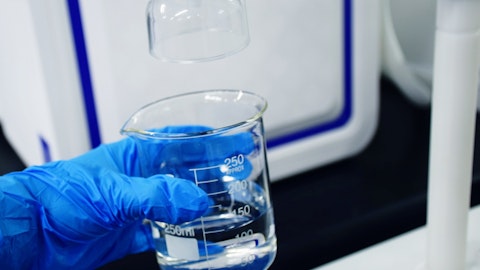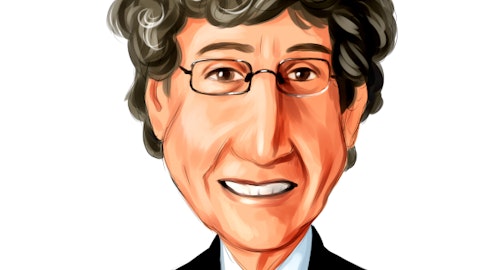Nick Green: Yes. I mean, I think Matt alluded to that and I’ll let him add to any comments I make, if you have got anything further, Matt. But I mean, I think we have had some really good response to the facilities. It’s been really quite nice over the last few months, probably the last five to six months, if not more available to people around without having to go and up and go and see every little bit of it and walk them around the flows and the like. And I think we’ve had nothing but good comments, positive comments and people very happy with this sort of high-quality capacity alongside Avid’s offering is going to be available shortly. So, we are delighted to be standing that up in the very near future. I think timing is pretty close to ideal.
I mean, obviously, I think on the first phase expansion that we did last year with DSP2, our backlog actually hit our capacity in the same quarter we brought it on line. So, we’d love to do that again this next quarter coming up. And if we did that, then I don’t think we could have timed it any better. So, again, my summary would be lots of really good interest and just excited to have it on line and then starting to fill it and then absorb some of those costs that we’ve invested in ahead of time and see that progression in margin. Matt, anything further on your side?
Matt Kwietniak: No. I think, well said. I think it’s accurate. A lot of client interest in the build-out and the additional space and a lot of excitement and positive, really great feedback. We’ve had a number of clients come out and actually tour the site as was early on in construction and eager to get back and see how the progress is going and get engaged. So, it shows very, very well. And there has been a lot of interest. So, we remain optimistic for sure.
Matt Hewitt: That’s great. Thank you very much.
Nick Green: Thanks, Matt.
Operator: Thank you. One moment for questions. Our next question comes from Jacob Johnson with Stephens. You may proceed.
Jacob Johnson: Hey. Thanks. Good afternoon. As we think about kind of forward-looking KPIs, I think backlog was a bit shy of what many of us had expected. But, you also had a record quarter in process development. Can you just talk about how — what that record quarter in process development could mean, as we think about looking forward? And then, just a related question. Can you remind us kind of how much process development capacity you have today and maybe where you are in the PD capacity expansion on the biologics side?
Nick Green: Yes. So, the PD is, in my view, a really encouraging sign. I mean, when somebody takes transfers of projects into the business, typically, we’ll go in, we’ll do some small scale runs in PD. Depending on the client, obviously, we may do some work on that process or if the process is already well developed, we’re just basically sort of demonstrating what they have already told us, ready for moving it across into the manufacturing facility. So, it’s really the front end of the business where things are coming in. So, to see those sort of revenues in there for me is a good indication that people are getting in. And then obviously we hope to see those people move from small 2 liter scales up to the larger 2,000 ultimately.
So, that to me is a really good indicator for where the business is heading. And then, in terms of the capacity, the 7 million this quarter is actually over capacity. I think, we’ve often talked about capacity is a little bit of a fungible number, because it’s not a perfect science. It can vary between certain different activities and whether you’re doing campaigns and all that sort of thing. So, we actually beat our capacity. We would’ve had our capacity down somewhere around 5 million for the quarter and we hit 7 million. So, that was really sort of the super quarter. In terms of where the capacity is going. So 5 million would give us 20 million a year, annual. We are doing the expansion that comes on in quarter one as well. And that would give us then effectively 40 million or 10 million a quarter, obviously give or take based on the super performance in the last quarter.
Jacob Johnson: Got it. Thanks for that, Nick. And then just as a follow up to maybe put a finer point on the gross margin discussion, I think cost of goods sold up sequentially. You called out a variety of things, but it sounds like a lot of hiring. And I don’t know if there’s a way to quantify kind of the number of people you have and the revenue that would support, but could you just talk about maybe as we think about the journey of staffing up the various capacity expansions, how much you accomplished during this quarter and maybe how much is left to go going forward?
Dan Hart: So, Jacob, so on the gross margin front, as far as heads, we ended the quarter at approximately 360 folks, which is up significantly over where we were last year. Looking forward as far as how many heads do we need to bring in, that’s kind of a function of what the anticipated growth looks like. And as we start to fill and backfill or add the specific needs that we see in the different groups — I think, that’s essentially kind of where we’re at, why we see that we’ll as we start to fill these expansions and start to load some of that additional revenue within that capacity, we’ll be able to absorb some of those costs as we move forward.
Nick Green: Yes. And I think the other part I’d add as well, Jacob, is that you see — you’ve seen the sort of costs come into the organization in different areas. So, for example, we started beefing up the commercial organization with additional BD representation. We also increased marketing and increased proposal writers and all those sort of things that are all on the front end with zero revenue associated with those. The initial BD calls, the marketing stuff, all of that doesn’t get any revenue. So that certainly hits the margins in the short term. Again, I don’t think we need very large numbers of increases in those areas to fill out those facilities. So, we don’t need to repeat those as we go forward. And that sort of goes then all also through the organization as you start to bring in project management and things like that that have got to onboard these in PD.
And then ultimately as we see going forward, and I think this is where you’ll see more of the growth as we go forward, is in the more hands on operational people where they’re actually making the batches. So, what you’ve seen is the early investment and effectively the hit on margin is by standing up all the things that you need to get the business in. And then, as we go forward now, then we’ll start to just apply the people, which is kind of the variable cost associated with a manufacturer.





